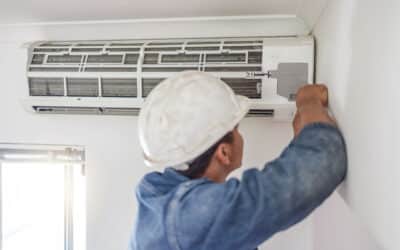Every household and workplace has an often-underappreciated champion diligently toiling away, safeguarding our contentment and health. This unsung champion is the HVAC system, a remarkable feat of contemporary engineering that meticulously manages our indoor environments, transforming unbearable sweltering summers and bone-chilling winters into environments of comfort. Over more than twenty years, we at Able Air Conditioning & Heating Inc. have dedicated ourselves to mastering the intricacies of this invaluable system, ensuring it functions seamlessly for your benefit. Come along with us as we embark on a journey into the captivating realm of HVAC Companies Cambridge, demystifying its complexities and highlighting its essential role in our everyday existence.
Experience the difference between advanced HVAC solutions; now explore our extensive HVAC services for a comfortable and energy-efficient home.
Demystifying HVAC Basics:
HVAC, an acronym for Heating, Ventilation, and Air Conditioning, is the technology that ensures our homes and offices remain at comfortable temperatures, irrespective of the weather outside. It’s not just about heating and cooling; it’s about ensuring the clean air and the optimal humidity levels.
-
Compressor:
The pivotal role in the temperature control system is played by the HVAC components, particularly the compressor. It acts as the heart of the cooling cycle, initiating the core circuit responsible for temperature regulation. By compressing the refrigerant, the compressor increases its temperature, initiating the cooling process when the refrigerant reaches the condenser.
-
Condenser:
By acting as the pivotal component in the air conditioning system, the condenser is responsible for ejecting warmth from the building and conveying it outdoors. In this process, the gaseous refrigerant changes into a liquid form. Some variations of heat pumps also include condensers designed to capture heat from the surroundings. Able air provides one of the best furnace repair Waterloo
-
Thermal Expansion Valve:
This valve is pivotal for the condenser’s operation. It depressurizes the liquid refrigerant, enabling its transformation from liquid to vapor. By precisely controlling the refrigerant flow into the evaporator coil, the expansion valve significantly boosts the system’s efficiency.
-
Air Handler (including Evaporator Coil and Blower):
The air handler plays a vital role in efficiently operating heating and cooling systems. This component, positioned in close proximity to the ductwork, is vital for distributing both cooled and heated air throughout the building, creating a comfortable indoor environment. The air handler, which comprises a blower and essential heating and cooling elements, relies on the evaporator coil as a critical component. This coil contains the chilled refrigerant supplied by the compressor and serves as a heat exchanger. As air from the blower fan courses over the coil, it facilitates heat extraction from the treated space, thereby contributing to the effective functioning of the heating and cooling systems.
-
Terminal Units:
These units encompass an air filter, coil, and blower. Their sizes can vary considerably. Standard terminal units in commercial HVAC systems include mid-sized rooftop units (RTUs) and larger make-up air units (MTUs). They can be employed to regulate temperatures in individual rooms.
-
Chiller:
Available in both air-cooled and water-cooled variants, chillers are designed to extract heat from the liquid flowing through the building’s pipes. Air-cooled chillers use fan-driven air to cool the condenser coils, while water-cooled chillers rely on continuous water recirculation.
-
Duct System:
Though often overlooked, the duct system is vital for HVAC performance as it distributes air throughout the building. Maintaining clean and intact ductwork is essential for the optimal functioning of the entire HVAC system.
-
Compressor:
By acting as the core of the cooling cycle, the compressor initiates the primary loop that facilitates temperature management. Compressing the refrigerant increases its temperature, allowing the cooling process to commence once the refrigerant reaches the condenser.
-
Condenser:
By serving as the hot segment of the air conditioning unit, the condenser expels heat from the building and transfers it outside. During this phase, the gaseous refrigerant transitions into a liquid state. In specific configurations, Heat pump installation Waterloo also contain condensers to gather external heat.
-
Thermal Expansion Valve:
This valve is pivotal for the condenser’s operation. It depressurizes the liquid refrigerant, enabling its transformation from liquid to vapor. By precisely controlling the refrigerant flow into the evaporator coil, the expansion valve significantly boosts the system’s efficiency.
-
Air Handler (including Evaporator Coil and Blower):
The air handler is tasked with circulating air throughout the system. Typically connected directly to the ductwork, it propels cooled or heated air into the building and recirculates it. The handler comprises a blower and heating/cooling elements. The evaporator coil, a crucial part of the air handler, contains the chilled refrigerant from the compressor. The heat from the treated area is extracted as the blower fan’s air passes over the coil.
-
Terminal Units:
These units encompass an air filter, coil, and blower. Their sizes can vary considerably. Common terminal units in commercial HVAC systems include mid-sized rooftop units (RTUs) and larger make-up air units (MTUs). They can be employed to regulate temperatures in individual rooms.
-
Chiller:
Available in both air-cooled and water-cooled variants, chillers are designed to extract heat from the liquid flowing through the building’s pipes. Air-cooled chillers use fan-driven air to cool the condenser coils, while water-cooled chillers rely on continuous water recirculation.
-
Duct System:
Though often overlooked, the duct system is vital for HVAC performance as it distributes air throughout the building. Maintaining clean and intact ductwork is essential for the optimal functioning of the entire HVAC system.
Heating and Cooling Systems Explained:
While the primary function of HVAC systems is to heat or cool spaces, the process is more intricate than it appears. Systems use a combination of fuel combustion, electricity, and refrigerants to regulate temperatures. The choice between heating and cooling is automated, with the system sensing temperature differences and adjusting accordingly.
Decoding HVAC Terminology:
The HVAC terminology can be overwhelming for those new to the HVAC world. Here’s a quick breakdown:
SEER (Seasonal Energy Efficiency Ratio): A measure of an air conditioner’s efficiency. The higher the SEER rating, the more efficient the unit.
BTU (British Thermal Unit): A measure of heat energy. It’s the amount of heat required to raise the temperature of one pound of water by one degree Fahrenheit.
AFUE (Annual Fuel Utilization Efficiency): A metric that gauges the efficiency of furnaces. It represents the ratio of heat produced for every dollar of fuel consumed.
These are only a few terminologies; to explore more, please visit our HVAC terminology page.
Conclusion – Empowering Through Knowledge:
At Able Air Conditioning & Heating Inc., an informed customer is a satisfied customer. With our competitive pricing and superior HVAC services, we’ve been the trusted choice for residents in Kitchener, Waterloo, Cambridge, Guelph, and surrounding areas. Our family-owned business takes pride in not just offering services but also in educating our clientele. With our expert knowledge in air conditioning, heating, and water heating services, we’ve garnered numerous 5-star reviews on Google and Facebook. For more insights, please stay connected with us through Yelp, Instagram, YouTube, and Twitter. Contact us for a free consultation today, and let us take care of your HVAC needs. We also provide one of the best AC repair Cambridge to your doorstep.



